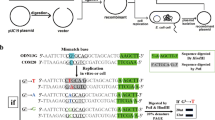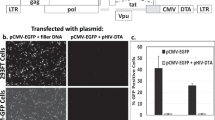Abstract
The multisubstrate deoxyribonucleoside kinase of Drosophila melanogaster (Dm-dNK) is investigated for possible use as a suicide gene in combined gene/chemotherapy of cancer. The enzyme has broader substrate specificity and higher catalytic rate compared to herpes simplex type 1 thymidine kinase and other known dNKs. Although the enzyme has broad substrate specificity, it has a preference for pyrimidine nucleosides and nucleoside analogs. We have evaluated the substrate specificity and kinetic properties of Dm-dNK proteins containing M88R, V84A+M88R or V84A+M88R+A110D mutations in the amino-acid sequence. These engineered enzymes showed a relative increase in phosphorylation of purine nucleoside analogs such as ganciclovir, 9-β-D-arabinofuranosylguanine and 2′,2′-difluorodeoxyguanosine compared to the wild-type enzyme. The mutant enzymes were expressed in an osteosarcoma thymidine kinase-deficient cell line and the sensitivity of the cell line to nucleoside analogs was determined. The cells expressing the M88R mutant enzyme showed the highest increased sensitivity to purine nucleoside analogs with 8- to 80-fold decreased inhibition constant IC50 compared to untransduced control cells or cells expressing the wild-type nucleoside kinase. In summary, our data show that enzyme engineering can be used to shift the substrate specificity of the Dm-dNK to selectively increase the sensitivity of cells expressing the enzyme to purine nucleoside analogs.
This is a preview of subscription content, access via your institution
Access options
Subscribe to this journal
Receive 12 print issues and online access
$259.00 per year
only $21.58 per issue
Buy this article
- Purchase on Springer Link
- Instant access to full article PDF
Prices may be subject to local taxes which are calculated during checkout

Similar content being viewed by others
Abbreviations
- Dm-dNK:
-
Drosophila melanogaster deoxyribonucleoside kinase
- HSV-1 TK:
-
herpes simplex virus type-1 thymidine kinase
- dAdo:
-
deoxyadenosine
- dCyd:
-
deoxycytidine
- dGuo:
-
deoxyguanosine
- dThd:
-
deoxythymidine
- AraA:
-
9-β-D-arabinofuranosyladenine
- AraG:
-
9-β-D-arabinofuranosylguanine
- dFdC:
-
2′,2′-difluorodeoxycytidine
- dFdG:
-
2′,2′-difluorodeoxyguanosine
- BVDU:
-
(E)-5-(2-bromovinyl)-2′-deoxyuridine
- FdU:
-
5-fluoro-2-deoxyuridine
- GCV:
-
9-(2-dihydroxypropoxymethyl)guanine
- ACV:
-
9-(2-hydroxyethoxymethyl)guanine
- PCV:
-
9-4-(hydroxy-3-(hydroxymethyl)but-1-yl)guanine
References
Culver KW, Ram Z, Wallbridge S, Ishii H, Oldfield EH, Blaese RM . In vivo gene transfer with retroviral vector-producer cells for treatment of experimental brain tumors. Science 1992; 256: 1550–1552.
Moolten FL . Tumor chemosensitivity conferred by inserted herpes thymidine kinase genes: paradigm for a prospective cancer control strategy. Cancer Res 1986; 46: 5276–5281.
Springer CJ, Niculescu-Duvaz I . Prodrug-activating systems in suicide gene therapy. J Clin Invest 2000; 105: 1161–1167.
Black ME, Newcomb TG, Wilson HM, Loeb LA . Creation of drug-specific herpes simplex virus type 1 thymidine kinase mutants for gene therapy. Proc Natl Acad Sci USA 1996; 93: 3525–3529.
Kokoris MS, Sabo P, Adman ET, Black ME . Enhancement of tumor ablation by a selected HSV-1 thymidine kinase mutant. Gene Therapy 1999; 6: 1415–1426.
Degreve B, Esnouf R, De Clercq E, Balzarini J . Selective Abolishment of pyrimidine nucleoside kinase activity of herpes simplex virus type 1 thymidine kinase by mutation of alanine-167 to tyrosine. Mol Pharmacol 2000; 58: 1326–1332.
Johansson M, van Rompay AR, Degreve B, Balzarini J, Karlsson A . Cloning and characterization of the multisubstrate deoxyribonucleoside kinase of Drosophila melanogaster. J Biol Chem 1999; 274: 23814–23819.
Zheng X, Johansson M, Karlsson A . Retroviral transduction of cancer cell lines with the gene encoding Drosophila melanogaster multisubstrate deoxyribonucleoside kinase. J Biol Chem 2000; 275: 39125–39129.
Zheng X, Johansson M, Karlsson A . Nucleoside analog cytotoxicity and bystander cell killing of cancer cells expressing Drosophila melanogaster deoxyribonucleoside kinase in the nucleus or cytosol. Biochem Biophys Res Commun 2001; 289: 229–233.
Zheng X, Johansson M, Karlsson A . Bystander effects of cancer cell lines transduced with the multisubstrate deoxyribonucleoside kinase of Drosophila melanogaster and synergistic enhancement by hydroxyurea. Mol Pharmacol 2001; 60: 262–266.
Degreve B, De Clercq E, Balzarini J . Bystander effect of purine nucleoside analogues in HSV-1 tk suicide gene therapy is superior to that of pyrimidine nucleoside analogues. Gene Therapy 1999; 6: 162–170.
Knecht W, Sandrini MP, Johansson K, Eklund H, Munch-Petersen B, Piskur J . A few amino acid substitutions can convert deoxyribonucleoside kinase specificity from pyrimidines to purines. EMBO J 2002; 21: 1873–1880.
Munch-Petersen B, Knecht W, Lenz C, Sondergaard L, Piskur J . Functional expression of a multisubstrate deoxyribonucleoside kinase from Drosophila melanogaster and its C-terminal deletion mutants. J Biol Chem 2000; 275: 6673–6679.
Johansson K, Ramaswamy S, Ljungcrantz C, Knecht W, Piskur J, Munch-Petersen B et al. Structural basis for substrate specificities of cellular deoxyribonucleoside kinases. Nat Struct Biol 2001; 8: 616–620.
Johansson M, Karlsson A . Cloning of the cDNA and chromosome localization of the gene for human thymidine kinase 2. J Biol Chem 1997; 272: 8454–8458.
Munir KM, French DC, Dube DK, Loeb LA . Herpes thymidine kinase mutants with altered catalytic efficiencies obtained by random sequence selection. Protein Eng 1994; 7: 83–89.
Eriksson S, Kierdaszuk B, Munch-Petersen B, Oberg B, Johansson NG . Comparison of the substrate specificities of human thymidine kinase 1 and 2 and deoxycytidine kinase toward antiviral and cytostatic nucleoside analogs. Biochem Biophys Res Commun 1991; 176: 586–592.
Solaroli N, Bjerke M, Amiri MH, Johansson M, Karlsson A . Active site mutants of Drosophila melanogaster multisubstrate deoxyribonucleoside kinase. Eur J Biochem 2003; 270: 2879–2884.
Acknowledgements
This work was supported by grants from the Swedish Research Council, the Swedish Cancer Society, the European Commission (Project QLRT-2000-01004), the KU Leuven (IDO project to JB), the Medical Faculty of the Karolinska Institute and the Hedlund Foundation.
Author information
Authors and Affiliations
Corresponding author
Rights and permissions
About this article
Cite this article
Solaroli, N., Johansson, M., Balzarini, J. et al. Enhanced toxicity of purine nucleoside analogs in cells expressing Drosophila melanogaster nucleoside kinase mutants. Gene Ther 14, 86–92 (2007). https://doi.org/10.1038/sj.gt.3302835
Received:
Revised:
Accepted:
Published:
Issue Date:
DOI: https://doi.org/10.1038/sj.gt.3302835



